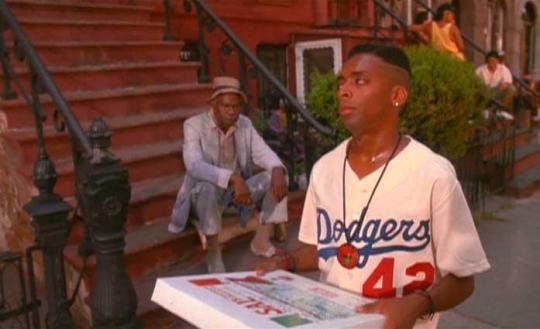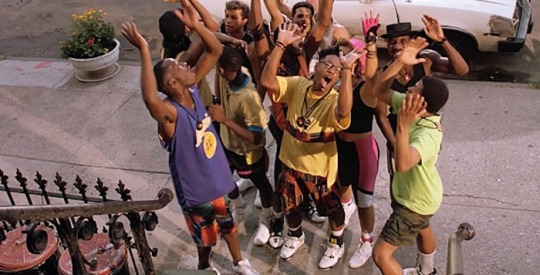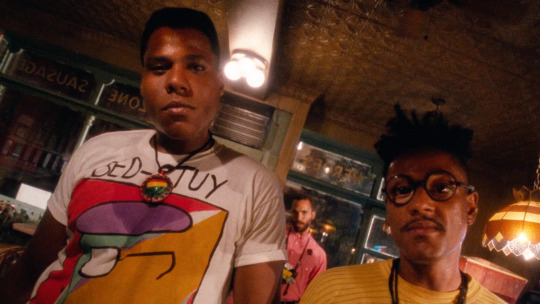#victims can be mad and jaded and not be SUPER RACIST ABOUT IT
Text
This may get me legit doxxed but I cannot believe Astarion is the fan favourite bg3 companion. The racist??? The racist old man who frequently and explicitly confirms that he is racist and will continue to be racist?? And it isn't even like. Goblin racism or something like Wyll where it's because they're "evil". He's racist against indigenous people and dehumanises short people. Which are also actual real human groups. And he explicitly refuses to change that behaviour.
#like a lot of characters express ignorance. but Astarion is like the only one who straight up goes “gur and gnomes are less than human”#he hates indigenous people because he had one bad experience with one group of them#thats like. literally the exact same thing my stepfather says to justify hating aboriginal australians. hes a gross old man#I just cannot believe it. especially here on tumblr#where the general consensus is that racism and bigotry is bad and inexcusable. but for this one guy it's fine?? because u think hes hot#this is radicalising me into an astarion hater because I cannot deal with you people. this is not like. “realistic victim rep”#victims can be mad and jaded and not be SUPER RACIST ABOUT IT#bg3
31 notes
·
View notes
Text
Do The Right Thing (1989), AFI #96




Our next film on the list that we reviewed was a more recent drama/comedy called Do The Right Thing (1989), directed by Spike Lee. Well, on a list with movies over 100 years old, a little over 30 is pretty new. It is the story of a single day in 80s Brooklyn and the drama that comes from frayed nerves under the boiling summer heat. The movie received a couple of Oscar nominations and Spike Lee received recognition for his directing and screenwriting. Danny Aiello also was recognized on the awards circuit for best supporting actor. There are some extraordinary aspects to this film that makes it stand out, but I also feel that it is lacking in many ways. The good strongly outweighs the bad, but I will discuss that more after the movie summary:
SPOILER WARNING!!! IT IS LESS SPOILERY THAN NORMAL DUE TO ALL THE CHARACTERS, BUT THE MAJOR POINTS ARE STILL GIVEN AWAY!!! WATCH FIRST AND COME BACK FOR THE ARTICLE TO GET THE BEST EXPERIENCE!!!
----------------------------------------------------------------------------
Mookie (Spike Lee) is a 25-year-old pizza delivery man living in Bedford–Stuyvesant, with his sister Jade. He and his girlfriend Tina (Rosie Perez) have a toddler son named Hector. Mookie works at a local pizzeria owned by Sal (Danny Aiello), an Italian-American who has been in the neighborhood for 25 years. Sal's eldest son Pino (Jon Turturro) is racist, and does not get along with Mookie. Because of this, Pino is at odds with both his father, who refuses to leave the majority African-American neighborhood, and his younger brother Vito (Richard Edson), who is friendly with Mookie.
Many distinctive residents are introduced, including Da Mayor (Ossie Davis), a friendly drunk; Mother Sister (Ruby Dee), who watches the neighborhood from her brownstone; Radio Raheem (Bill Nunn), who blasts Public Enemy on his boombox wherever he goes; and Smiley (Roger Smith), a mentally disabled man who meanders around the neighborhood trying to sell hand-colored pictures of Malcolm X and Martin Luther King Jr.
While at Sal's, Mookie's friend Buggin' Out (Giancarlo Esposito) questions Sal about his "Wall of Fame", a wall decorated with photos of famous Italian-Americans. Buggin' Out demands that Sal put up pictures of black celebrities since Sal's pizzeria is in a black neighborhood. Sal replies that it is his business, and that he can have whoever he wants on the wall. Buggin' Out attempts to start a boycott over the Wall of Fame.
During the day, local teenagers open a fire hydrant and douse the other neighbors to beat the heat wave before officers intervene. After a phone call, Mookie and Pino begin arguing over race. Mookie confronts Pino about his negative attitudes towards African Americans, although the latter's favorite celebrities are black. Various characters express racial insults: Mookie against Italians, Pino against African Americans, Latino Stevie against Koreans, white officer Gary Long against Puerto Ricans, and Korean owner Sonny against Jews. Pino expresses his contempt for African Americans to Sal, but Sal insists that he will not leave the neighborhood.
That night, Buggin' Out, Radio Raheem, and Smiley march into Sal's and demand that Sal change the Wall of Fame. Raheem's boombox is blaring and Sal demands that he turn it off, but he refuses. Buggin' Out calls Sal and sons "Guinea bastards" and threatens to close down the pizzeria until they change the Wall of Fame. Frustrated and angry, Sal calls Buggin' Out a "n****r" and destroys Raheem's boombox with a bat. Raheem attacks Sal, leading to a fight that spills out into the Street and attracts a crowd. While Raheem is choking Sal, the police arrive. They break up the fight, and apprehend Raheem and Buggin' Out. Despite the pleas of onlookers, one officer refuses to release his chokehold on Raheem, killing him. Realizing that Raheem has been killed in front of witnesses, the officers place his body in the back of a police car and drive off.
The onlookers, devastated and enraged about Radio Raheem's death, blame Sal and his sons. Da Mayor tries to convince the crowd that Sal was not responsible for his death but the crowd remain where they are. Mookie grabs a trash can and throws it through the window of Sal's pizzeria, sparking the crowd to rush into the pizzeria and destroy it. Smiley sets the building on fire, and Da Mayor pulls Sal, Pino, and Vito out of the mob's way. The police return to the sight, along with firemen and riot patrols arrive to put out the fire and disperse the crowd. After they issue a warning, the firefighters turn their hoses on the rioters, leading to more fighting and arrests. Mookie and Jade sit on the curb, watching in disbelief. Smiley wanders back into the smoldering building and hangs one of his pictures on what is left of Sal's Wall of Fame.
The next day, after an argument with Tina, Mookie returns to Sal. He feels that Mookie had betrayed him, but Mookie demands his weekly pay. The two men argue and cautiously reconcile, and Sal finally pays Mookie.
The film ends with two quotations that express different views about violence, one by Martin Luther King and one by Malcolm X. It fades to a photograph of the two leaders shaking hands. Prior to the credits, Lee dedicates the film to the families of six victims of brutality or racial violence: Eleanor Bumpurs, Michael Griffith, Arthur Miller Jr., Edmund Perry, Yvonne Smallwood, and Michael Stewart.
----------------------------------------------------------------------------
I want to break this into the good and the bad (at least in my humble opinion). I want to start with the great cinematography and the director of photography Ernest Dickerson. He really brought the city to life and made the overheated neighborhood into a character. He used reds and oranges and avoided greens and blues. All of the clothes were sweaty and stained. There were also some beautiful walking shots that followed Mookie as he moved through the neighborhood. Some of the best camera work was the close-ups of Radio Raheem because the shot would tilt to a Dutch angle every time he got mad. It gave the feeling like things were going askew.
Because it was shot on location in Brooklyn, one could use Google maps and see the actual neighborhood. It was mapped out so well, however, that I didn’t need the map and could draw out the locations of the homes and businesses from a single watch. Dickerson did a phenomenal job of setting the stage for Spike Lee’s story and has done great work on many of Lee’s other films including She’s Gotta’ Have It (1986), School Daze (1988), Do The Right Thing (1989), Mo’ Better Blues (1990), Jungle Fever (1991), and Malcolm X (1992). Great team and a great bunch of movies. Dickerson has since moved to directing and well worth following.
I thought the short comic stories that came together were pretty great. Somebody accidently stepped on Buggin’ Out’s shoes and scuffed them. He threatened the guy who did it and got a whole group of people to help and try to coerce money out of the offender. It eventually turned out that he was all talk. But the shoes kept popping up over and over. The three men sitting and complaining while not actually doing anything was pretty funny. The hatred that Sister/Mother had for Da Mayor was pretty good as well. There were a couple pretty good laughs.
I love the character of Radio Raheem played by Bill Nunn and how he represented the underlying anger of the neighborhood. He just walked around trying to do his thing and listened to his super loud music. The black residents recognized him and knew he had become part of the landscape while other residents tried to get him to be quiet and suppress him. When he was killed, the anger that he represented was released and the group went into a frenzy of destruction. Raheem’s interaction with each of the other characters truly defined how director Spiker Lee wanted the audience to see that person. The movie really shines with any scenes involving Radio Raheem.
As far as the acting is concerned, I really liked the work of Danny Aiello, John Turturro, and Richard Edson. I don’t want to be accused of anything because I liked the work of the three main white actors, however I feel that the three characters trying to fit into a place where many felt they did not belong was the most intriguing. Sal seemed like such a good guy, but he still had some underlying hatred and fear of black community and it became apparent when he was faced with Radio Raheem, the representation of the suppressed black anger of the neighborhood.
The six people to whom the movie was dedicated were all black Americans in the New York area who had died in suspicious and racially charged violence. I normally don’t recommend this site, but Wikipedia provides links to learn more about all of the people mentioned. It seems that a lot of Spike Lee’s characters were based on the different people mentioned. I had never realized how closely tied this film was to the history of violence in 80s New York, and it does make me like the film a lot more.
Now for a couple of things that I really did not enjoy. The main character Mookie was not that interesting beyond just being a vehicle that walks through the day. When it got to the point where he couldn’t take any more and he smashed the window (whether it was to protect Sal by directing the anger towards the store instead of Sal and his sons is up to interpretation) seemed so out of character. Like everyone stopped and stared as he did something that his character had no motivation to do. This could just be a personal critique because I found Spike Lee’s acting so unconvincing (the guy can’t emote, he is a director not an actor) and I think giving his boring character control of the turning point at the climax of the movie was a little bit of director ego.
I also didn’t like the random white guys that were with the cops that killed Radio Raheem. Where did they come from and where did they go? The cops show up to break up the fight between Sal and Raheem and suddenly there are some plain clothed white guys that I didn’t remember being in the rest of the movie. It seemed like they came from the surrounding streets and there was one guy in particular who was in a blank tank top that helped subdue Radio Raheem that just disappeared. Wouldn’t the police want to take him into custody as well or at least not leave him on the street with a large angry mob? The sudden appearance of all these extras for the one scene has always thrown me. It feels like they took stock footage from a different movie and plugged it in, or maybe it was shot long before or after the rest of the scenes in the film.
I did not like Rosie Perez’s character of Tina. Perez had been a professional dancer and this was her big break. I really didn’t think the opening with her dancing was noteworthy in any way, her famous ice cube scene was completely unnecessary, and the ending with her complaining was horrific. Honestly, the ice cube scene shows Spike Lee rubbing a piece of ice on Rosie Perez’s naked body and it felt pervy and inappropriate. I do not correlate all nudity in a movie with automatically meaning it is not for kids (depends on the movie and depends on the kid), but this was just dumb. This was a point of contention with the group that watched with me, some saying she was the best part of the film. I could not disagree more and I rated it 3/5 on Netflix noting that it would be 4/5 if Perez had not been in it. She really rubbed me the wrong way in the film. I liked her in White Men Can’t Jump playing a similar character, but in this movie she was not needed.
In fact, there seemed like there were many extra things that didn’t need to be there. There is about 2 minutes in which five characters make racist rants about other ethnic groups with the camera right in their face. This seems like art for art’s sake and not really needed. The character of Smiley seemed very out of place and it turns out that he was not in the original screenplay but written in so that the actor could have a part. The DJ just said the same things over and over with no real insight. He was played by Samuel L. Jackson, which is cool, but he also didn’t need to be there. I guess my biggest gripe is that Spike Lee had a great film idea with strong characters and then decided he needed to keep layering in more characters and subplots until it was superfluous. But again, just an opinion.
I saw that Siskel & Ebert both rated the movie as one of the top 10 of the 80s. Both of them had opinions about whether or not Mookie did the right thing, which is not a question that Spike Lee intended to ask (as he stated in many interviews). I think it was (and is) refreshing to have a strong black voice in the director’s chair and this might have affected their rating. Maybe, since I was 9 when this film came out, I am not affected enough by how new and innovative this film must have seemed when it came out. I started to become aware of the world shortly after this movie was released and I was inundated with Spike Lee in films and advertisements. His work didn’t seem so fresh when I also saw him in commercials for Nike and McDonald’s. I shouldn’t allow that to take away from the importance of his voice as part of the history of American cinema. He is the only black director of any movie on the AFI top 100 films and only one of two directors of color (M. Night being the other).
So does this film belong on the AFI top 100? Yes. It is a good story of American life in an area that was often ignored. The streets of Brooklyn are just as American as the farms in Iowa, the plains of Cheyenne, or the suburbs of California. It is great to have those stories told by a man who grew up there and knew the different life styles and the different problems. It is an important movie and I am glad it was included. Would I recommend it? Yeah, it is pretty good. I would say focus on the interactions between Raheem and the other characters and it makes for a great story. Definitely worth checking out.
#spike lee#80s films#do the right thing#brooklyn#black voices#introvert#introverts#afi films#american movies
5 notes
·
View notes